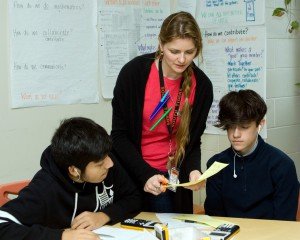Article and photos by MARGIE O’LOUGHLIN
In an annual competition, outstanding educators are chosen from each state to receive the Presidential Award for Excellence in Math and Science Teaching. This is the nation’s highest honor for teachers of math and science. The winners receive a certificate signed by the president, an all-expense-paid trip to Washington DC for recognition events, professional development opportunities, and a check for $10,000 to use as they wish.
 Two Minnesota math teachers are state finalists this year and, defying statistical odds, they both teach math at South High School. Morgan Fierst and Stephanie Woldum are colleagues and friends who applied for the award together.
Two Minnesota math teachers are state finalists this year and, defying statistical odds, they both teach math at South High School. Morgan Fierst and Stephanie Woldum are colleagues and friends who applied for the award together.
Photo right: Stephanie Woldum
“That application was a hefty one,” Woldum explained, “requiring a 12-15 page lesson plan, detailed analysis of instructional methods and, worst of all, a teaching video.”
The Minnesota winner has yet to be announced, and because the timing depends on the president’s schedule, it could be some time before winners are announced. Despite that, the exemplary work of both Fierst and Woldum is drawing attention.
Fierst teaches advanced algebra and advanced statistics. She’s in her seventh year at South, and has, she said, ”gotten really serious about teaching kids to use math in everyday life.”
For example, her advanced algebra students learned to apply geometric sequencing to examine the sub-prime mortgage crisis a few years ago. In class, several groups were assigned different interest rates and terms on their fictional mortgages. They studied what the real cost of each mortgage was over time, and how major lenders used their strategies to prey on low-income customers.
 “We’re going to start a unit on college loans next,” Fierst said, “comparing subsidized and unsubsidized loans, and public versus private lenders.”
“We’re going to start a unit on college loans next,” Fierst said, “comparing subsidized and unsubsidized loans, and public versus private lenders.”
Photo right: Morgan Fierst
Lisa Ramirez, public relations coordinator for South, added, “Any student coming out of Morgan’s class knows how to use math well beyond the classroom.”
Fierst’s clear message to her students is to be persistent in their practice of math. To demonstrate the value of persistence, she built a “Backwards Bike” for her classroom. When a rider turns the handlebars to the right, the bike actually swings left and vice versa. To balance and ride the Backwards Bike successfully requires retraining the brain to expect the unexpected.
Fierst believes that “if you have a fixed mindset, you either think you are, or aren’t, good at math. If you have a growth mindset, you believe that you can improve at anything, even riding a Backwards Bike, with patience and persistence.”
Woldum, herself a graduate of South, is in her tenth year of teaching there. Her motivation for teaching is to help students build their confidence and to learn the process of being successful at school. “We work tirelessly to have ‘aha!’ moments here,” Woldum said.
A studio arts major in college, Woldum had an “aha” moment herself when she realized she would rather be a mathematician than a sculptor. She graduated with a studio arts degree but went back and took seven additional advanced math classes, earned her teaching certificate, and more recently, her masters degree in math education.
Woldum’s creative side continues to shine in her classroom, which is filled with colored construction paper, scissors and many other “hands-on” materials to express numeric concepts. “I don’t use a textbook for any of the intermediate algebra sections I teach,” Woldum explained. “I know that I have to cover scatter plots and regression lines, everything the Minnesota State Standards require, but I can design my own methods for how to do that.”
”I got off to a really bad start with math when I was young,” Woldum said. “I failed algebra in middle school, and that sense of not ‘getting it’ strongly affected the way I relate to my students. Two years ago I wrote a proposal that was accepted by the school, to create a Math Center where students could come for extra help. A different math teacher staffs the center each hour of the school day, and there are student tutors too—like Chris Rounds, a soccer playing junior who earns service hours for the National Honor Society by volunteering in the Math Center. There have been thousands of student visits since the center opened.”
Fierst and Woldum may have different teaching styles, but they share a common language around math and learning. Both encourage a spirit of inquiry in students, reinforcing a sense of growth and confidence in learning. Regardless of the eventual outcome of the Presidential Award for Excellence in Math and Science Teaching, it would appear that the state of Minnesota has two winners this year.
Comments
No comments on this item Please log in to comment by clicking here